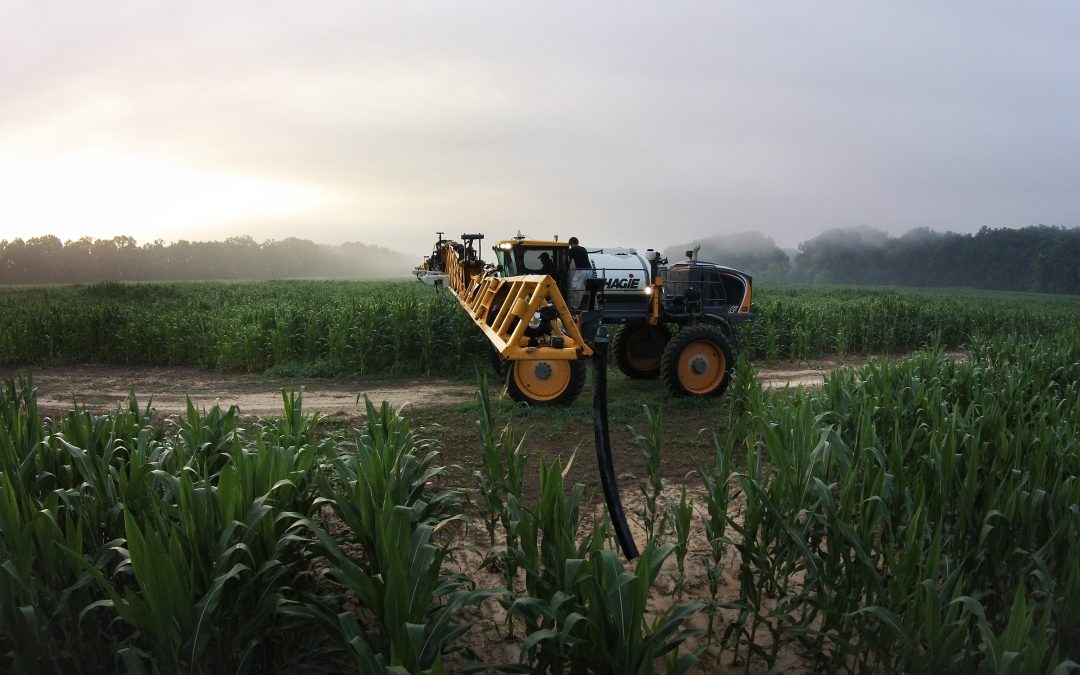National Poultry Technology Center
The ever‐evolving modern poultry house has gained numerous energy efficiencies over the last few years. Improvements in tightening techniques and insulation technology and in ventilation systems, control systems, lighting and heating—almost all areas of input costs have received much attention and have seen great improvements.
Now, with the current efforts in rainwater harvesting being explored and utilized on National Poultry Technology Center test farms, one might be tempted to say there is not much fat left to trim out of the modern poultry farm. However, solar energy also can be added to this list. We are not talking about solar heating but actually using solar energy to generate electricity.
Solar electricity is not a new idea. Everyone has used and benefits from photovoltaic (PV or solar cell) power generation. You probably have a calculator on your desk that uses PV cells to power it instead of batteries. The technology of converting the sun’s light energy into electricity has been around for a long time and is continuing to evolve and improve. In fact, this idea is not even new to poultry housing in the Southeast. There are currently more than 25 poultry farm solar installations going on in north Alabama alone.
There are not many things in this world we can say are truly free, but the sun’s light energy is one of them. With the increasing cost of power being driven further and faster by increasing bird demands, it is time poultry growers seriously consider opportunities in solar power. The problem is that a system that harnesses this “free energy” is anything but free. In fact, it can be very costly, particularly if done incorrectly without a full understanding of how it all works.
If done properly with all the right supporting factors, however, a grower has the opportunity to lock in his or her future electricity costs at a constant lower rate while paying for the system. Once a system is paid for, a grower can thereafter be virtually self‐sustaining in electricity well into the future with little more than the cost of insurance and maintenance for the solar system. With current electricity costs for high-wind-speed houses continuing to climb, this can equal a substantial boost to the grower’s bottom line.
The biggest misunderstanding with solar energy in poultry operations is that most think you are directly using the electricity being produced, thus allowing you to be “off the grid,” totally independent of the power company. While this is technically possible to do, it is totally impractical and currently economically infeasible for a modern poultry farm. There are several reasons for this impracticality.
First, PV cells produce DC power. That has to be converted to AC power to be utilized in a poultry house to run motors, lights, etc. Since PV cells only produce power when the sun shines, to be totally off the grid and totally self‐sufficient and apart from the power company, you would have to utilize a large array of batteries to store the power being produced by the PV cells and then convert that DC power back to AC power to use it when the sun isn’t shining. You can imagine how much battery storage capacity it would take to supply a modern poultry house and the cost associated with such a storage and conversion system. It is simply uneconomical with the current best battery systems available. This may change as battery technology improves, but we are not there yet.
Second, the current solar systems are very reliable with little maintenance required. However, the dependability of most all utility company power is also extremely good. Most growers have back‐up generator systems to cover them during the few times the utility company power fails. If a grower was using a solar system, with all its inverters, transformers, batteries, controllers, etc., for primary power, they would be relying on two complicated mechanical and electronic systems to always be working to supply power. The power companies simply do such a good job at supplying power consistently and dependably, it is impossible to replicate this peace of mind and assurance of power with any self‐contained system.
For these reasons, it is not feasible or smart for growers to consider any system that unplugs them from the power company. So the question is, Just how does this solar system save me money? The short answer to the question is through net metering.
How net metering works
Power companies have to produce the power you purchase from them. They have to build and maintain the distribution system. And, they have to anticipate and react to ever-increasing demands for electricity. They do this at a very successful level and for surprisingly low cost to the end user, especially if you consider everything that goes into your ability to plug into your wall and get power at any time.
However, the increasing costs of production and increasing demands often mean ever-increasing power bills, as the utility companies try to keep up with demand. Many people may not realize that utility companies are regulated by the public service commissions or legislatures of the states they do business in. This regulation controls just how much the utility companies can charge for the power they supply. That means that utility companies are always in search of newer, better and less expensive ways to produce and distribute electricity. Enter solar electricity production.
Solar energy has proved to be a highly efficient, low maintenance way to produce electricity. In fact, many utility companies are investing in large solar production facilities, or “solar farms,” to harness the sun’s free energy to produce electricity. Any method of electricity production is most efficient when you can produce the electricity close to the same areas of the highest usage, thus decreasing distribution costs in the form of power lines, substations, etc.
If a grower is not directly using the electricity he or she is producing with a solar system, then just how does it all work? Simple; it is all about the power meter. We are probably all familiar with how the meter works—when you use electricity from the power company, the power meter counts those watts and adds them up over time, turning that number into kilowatt hours (kWh), the unit by which you get charged for electricity.
Now imagine if you could turn that meter backward. This is in essence how net metering works. There are several forms of the actual metering systems depending on the utility company in question, but the principle is the same. As the solar system produces power and feeds it into the power grid, the meter flows in the direction of the grower. When the grower uses power from the grid, the meter flows in the direction of the utility company.
At the end of the month, the difference, or the net, is what the grower pays for, or in some cases, what the utility company pays the grower—according to who received more electricity in the month. The poultry growers’ ultimate goal is to produce as much electricity and feed it back into the system as they use off the system, thus netting out at a zero power bill. It can be pictured another way: You are selling power to the utility company at the same time you are buying power from the utility company. At the end of the month, you hope to have sold as much or more than you bought.
All power utility companies that participate in net metering have certain rules and regulations for their programs. Many limit how much power you can produce by limiting the size of a system at any location. Others limit the number of kWh they will pay for. Most often, they limit the kWh they will pay for to be equal or less than your annual usage averaged over time, thereby guaranteeing you can only zero out at best and not get ahead of the utility company.
Many will limit the rate per kWh they pay for the power produced by solar. Some companies pay retail rates, while others, only wholesale. There have been times when a utility company is in an expansion mode and chose to offer incentive rates to encourage local production. Still others have purchase rates that change with seasons and usage patterns. All participating utilities will have guidelines that must be met to tie your system into their grid.
These net‐metering guidelines are often regulated again by the state under formalized net‐metering laws. These laws are set in place by state legislatures and public service commissions to assure both the power client and the utility company have the opportunity to operate profitably in this unique system.
As of the writing of this report, Alabama does not have a statewide net‐metering law, thus it is left solely to the individual utility companies in Alabama to define if and how they will participate in any net‐metering activity. Therefore, it is paramount for any grower who is considering solar energy production to find out exactly how their utility company provider operates in regards to net metering as well as how their state laws regulate the system. Without at least a somewhat favorable net‐metering opportunity, solar energy production is in no way a feasible choice for poultry growers.
Solar power economics
The durability, weight, lifespan and efficiency of PV cell panels are improving rapidly. These improvements are fast reducing the overall cost per watt of electricity produced to record lows, with newer technology promising to continually drive the cost lower in the near future. As new technology lowers the costs, it also shortens the payback period of a system, given that there is favorable net metering available through the utility company.
It wasn’t too many years ago that solar power was costing $6 to $7 per watt of installed capacity. Now that figure is $2.25 per watt for average-size installations. Larger installations can easily see a $2-per-watt installed cost. And the cost is projected to continue to fall over the next several years.
Even at these low costs, the average 50-kilowatt system will come in at an installed cost of $100,000 to $115,000. This forces poultry growers who are in favorable net‐metering areas to consider all the possible contributing factors, such as available tax credits, other government incentives, decreased loan interest rates, depreciation opportunities and lease options.
It should be noted that third-party purchasing, with many alternative lease‐back and ownership programs to the grower, have been poultry grower–friendly in some areas. However, like net metering, this third-party purchasing is not approved in some states. Check your local utility company and/or public service commission for details.
The payback numbers for a solar system are variable depending upon the above cost factors and the cost of electricity in the area. Solar panels produce power at the rate of 1,350 kWh per year. So, a 50 kW solar system will produce 67,500 kWh of electricity in a year. If you are currently paying 11 cents per kWh to the power company, a 50 kW solar system could offset $7,425 of your current annual power bill, assuming you currently use that much power and your utility company offers a full offset opportunity.
Considering all the numbers, the average poultry farm with favorable solar opportunities can expect a final payback period of eight to 12 years on a 50 KW system. Any cost‐share, tax‐credits or grant monies that reduce install cost would reduce this period.
System lifespan is very good. PV panels degrade at a slow rate of ½ of 1 percent per year. This means they have a usable lifespan of 25 to 30 years before their efficiency drops to the point of needing replacement. Most systems will come with a 25-year warranty on the panels themselves and a 10 to 15-year warranty on the power inverters. It is advised that the inverters be upgraded and replaced in the same 10 to 15-year span.
Engineering considerations
Insurance companies, builders, integrators and growers all have an interest in how a solar system is installed on a poultry farm and what the associated risks are. First, it is absolutely imperative that any solar system be installed by a reputable, experienced solar installer. A well-designed and -installed system has built-in safeties regarding electrical shock risk for human injury.
There are also life-safety switches and controls that must be in place to assure the safety of utility workers when they are performing maintenance or repairs on their connected lines. Strict adherence to the power utility company’s guidelines for life safety is required and no shortcuts can be tolerated. But if systems are well designed and installed, they have proved safe for all parties.
A properly designed system will not cause any interference with normal power supply from the utility company. If, for any reason, the solar system experiences problems and stops producing electricity, a properly designed system will never cause the houses to be out of power, since the houses are not directly using the solar power. The utility power source would still be available. This also would not affect the ability of the backup generator to supply power as needed.
There are also questions concerning physically installing solar panels onto a poultry house roof. This installation opportunity makes solar uniquely attractive to poultry growers, as no land has to be utilized and taken out of otherwise useful production.
For example, a typical 50KW-solar system being installed in the Southeastern U.S. today takes up approximately 4,000 square feet of space. This is less than one half of one side of the typical poultry house roof. Solar panels in the northern hemisphere should optimally face in a southerly direction to get the most of the sun’s energy. With many poultry houses running east to west, this yields a convenient, optimal southward-facing roof for solar panel placement.
The weight of the panels themselves is minimal and should pose no risk for a poultry house with a well‐designed truss system in good repair. However, it is always advisable to have your roof/truss system inspected by a professional prior to installing a solar system. The greatest concern is in an area that experiences heavy snow or ice loads in the winter. If your houses are in such areas of the country, extra caution is needed, and it is advisable that a structural engineer be consulted before installation. Caution is also necessary if your poultry houses are more than 20 years old or have roof systems built on less than a 5-inch/12-inch pitch. In these cases, you may not have an optimal installation site on the poultry house roof.
If the poultry house roof is undesirable for mounting the panels, you can still explore a ground-mounted system. Ground-mounted systems are often the preference of growers and installers alike. Ground-mounted systems are becoming more prevalent as many poultry houses are no longer being built strictly in the east/west fashion.
Ground-mounted systems can sometimes be installed less expensively, but they also carry more maintenance, as the surrounding areas must be kept clear of weeds, are more prone to damage by debris or livestock, and are considered an eyesore by some people. Either system will work and produce the power for which it is designed. Consider all options, and choose the best for your situation.
The modern solar panel is very durable and not easily damaged. Rain, snow and hail pose little threat. But if a panel is damaged, it’s modular and can be replaced with a single piece.
Dennis Brothers, Jess Campbell, Jeremiah Davis, Gene Simpson and Jim Donald contributed to this report.





